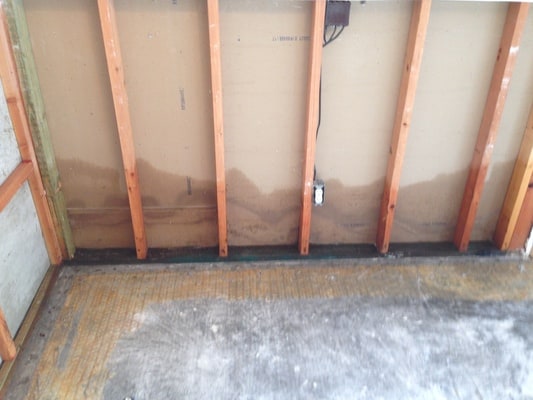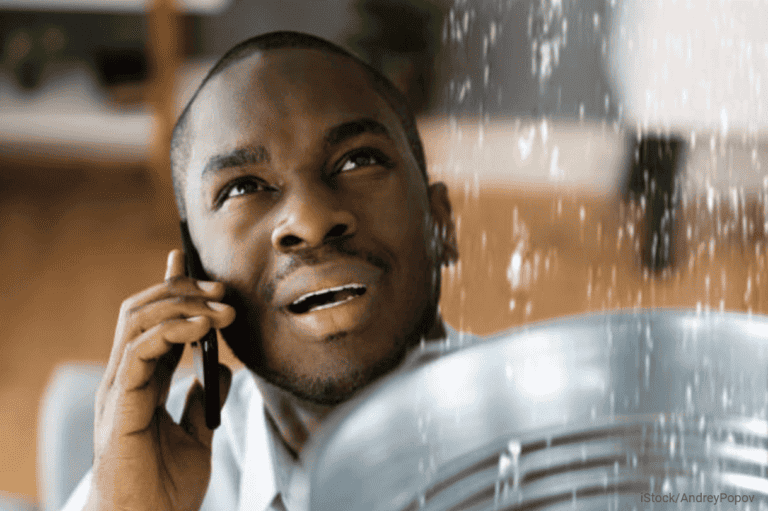Whether the water damage you’re dealing with is small or huge, it’s a stressful ordeal! We get it; as professional water damage restoration and mold removal specialists, we here at Cleaner Guys walk people through water damage daily.
One of the big questions people usually have is “Can water damage cause mold?”. We’re here to give you the ultimate guide on how to deal with this issue, and all the questions surrounding it.
Table of Contents
- So, CAN Water Damage Cause Mold?
- How Likely Is Mold After Water Damage?
- How Do You Know If You Have Mold After Water Damage?
- Is Mold Dangerous?
- What Are Signs of Mold Sickness?
- How Do You Keep Mold From Growing After Water Damage?
- What to Do When There’s Water Damage AND Mold?
- How Long Does Water Damage Restoration Take?
- How To Prevent Water Damage In the Future
- More Resources
- If You Live in Western Washington State…
So, CAN Water Damage Cause Mold?
Yes, unfortunately, water damage can cause mold, and unless the water damage is treated properly, it will. Drywall is absorbent, and practically all modern buildings use drywall for their walls and ceilings. Mold will grow inside the walls where you can’t detect it, once water is inside drywall.
Mold thrives the most in moist, dark, warm environments, which is exactly what your walls become after water damage. This is why it’s imperative to take care of the water damage immediately (more on this in a later section).

The photo above is from an actual Cleaner Guys job site. This is what the inside of a wall looks like when it absorbs water from water damage. The outside of the wall can often look totally normal! At least for a while.
How Likely Is Mold After Water Damage?
If the water-damaged area is not dried out within 24-48 hours, mold will almost certainly grow. Mold spores are always in the air, all around us, just like dust, bacteria, and pollen. Therefore, mold spores will begin rooting as soon as an environment is created where mold can thrive.
This is why it’s essential to hire a professional water damage mitigation company as quickly as possible. Good mitigation and restoration companies like Cleaner Guys know this, and they offer 24/7 on-call service, because they know how important it is to get the space dried out in time, to prevent mold.
Click here to learn how to find a mitigation company with 24/7 service.
How Do You Know If You Have Mold After Water Damage?
Once there is water inside your walls — whether from a leak or a flood — mold will almost certainly grow there. But since it’s inside the wall, how can you even know it’s there? Luckily, there are ways to tell whether there is water damage and mold in your walls. Here are the top things to look for.
- Staining or spotting. Brown or grey water stains indicate that the drywall is saturated with water. Clusters of black, grey, or brown spots is almost certainly mold, which means your water-damaged drywall is already moldy.
- Odor. If the area where the water damage occurred begins to smell musty or foul, there’s probably mold growth.
- Bubbling or peeling paint or wallpaper. A sure sign that shows that all or some of the drywall is saturated with water.
- Spongy drywall. If any part of the wall is soft to the touch, your drywall has been compromised by water.
Is Mold Dangerous?
Yes, mold can be dangerous to both your home and your health. Mold feeds on organic material, and in a water-damaged wall cavity, that means the wooden framing and the drywall itself. If mold-infested framing and drywall are neglected long enough, the safety of the structure of your home will be compromised!
A couple of species of mold are extremely toxic. However, most molds just cause mold sickness and allergic reactions in the people residing in the water-damaged space. Mold sickness symptoms range from almost nonexistent in some people, to life-threateningly severe in others.
For example, our professional mold removal team here at Cleaner Guys is typically asymptomatic to mold. Nevertheless, we always wear protective PPE (Personal Protective Equipment), including masks, to minimize the inhalation of mold. However, mold can have horrifying effects on others, such that they cannot even remain in their homes.
You can listen to one such harrowing story below. It’s from a popular podcaster with severe previous health conditions who was completely bedridden by hidden mold in her home. All credit and rights to the audio below belong to Mikhaila Peterson.
What are Signs of Mold Sickness?
The symptoms of mold sickness typically include abnormally long-lasting or out-of-season cold symptoms, such as a runny nose, incessant cough, constant headaches, or itchy eyes. In those with severe allergic reactions to mold, the symptoms can expand to include difficulty breathing, fever, and fatigue.
Learn more about what you need to know about mold sickness here.
How Do You Keep Mold From Growing After Water Damage?
If you haven’t done this already, the #1 thing you must do when you suffer water damage is to hire a water damage mitigation company. Click here to learn the inside tricks on how to choose one wisely.
Letting a professional water damage mitigation company clean up and restore your water damage is absolutely essential. They have professional equipment and cleaning products specifically designed for safely and effectively dealing with water damage. These kinds of equipment and products are ones you can’t get your hands on yourself because they’re commercial industry-specific.
One example is the InjectiDry HP-PLUS Drying System (pictured below). We here at Cleaner Guys love this equipment. It is specifically designed to dry out the inner cavities of walls after water damage. The system of yellow hoses you see in the photo connect to a high-power commercial contractor fan. We drill small holes into the damaged wall, and the hoses are carefully inserted and secured.
This one piece of equipment often allows Cleaner Guys’ clients to keep their walls intact! It’s just one example of what a professional water damage company has that a layperson cannot safely or effectively replicate on their own.

If Wall Cavity Drying Equipment Doesn’t Work
Professional mold removal specialists should be the only ones to remove and replace any unsavable materials. You also need proper PPE and the right training to know how to remove and assess all materials safely.
The materials that most commonly get removed and replaced are drywall, flooring, framing, and subflooring. We strongly advice you not to attempt to do this scale of remediation and repair on your own. In our 50+ years of combined experience, we’ve seen nearly all DIY water damage repair jobs go south.
Learn more about the professional water damage mitigation process and steps here.
What to Do When There’s Water Damage AND Mold?
If you have discovered that you have mold as well as water damage, the most important thing to do is, again, to call a professional water damage mitigation company. Do not try to DIY the water damage cleanup. Water damage DIY repair is not recommended, safe, or effective.
The water damage company will dry out the affected area as quickly as possible. This may take days, depending on the size of the damaged area. The company will then tear out and replace any materials necessary.
How Long Does Water Damage Restoration Take?
Water damage restoration can take anywhere from days to months, depending entirely on the size and scope of the damage. Mitigation is the process of drying out the area and removal of damaged materials. Restoration is the process of replacing all the damaged materials to how the space looked and functioned before, or better.

How to Prevent Water Damage in the Future
There are a few things you can do to help prevent water from absorbing into your drywall and flooring! Or at least to slow it down, so that the damage is less severe.
First, use satin or semi-gloss paint in the rooms that most commonly suffer water damage. We recommend the bathroom, kitchen, and laundry room, as these are the areas where we most commonly see water damage. Matte and eggshell paints are the most common choice for living rooms, bedrooms, and more. However, only satin and semi-gloss paints are water-repellent. We highly recommend their use for bathrooms, laundry rooms, and kitchens, to add a layer of water resistance to your drywall.
Second, re-caulk about once a year. Caulk keeps all the edges of your trim and masonry looking pretty, but did you know it’s also crucial for sealing off your drywall and flooring from water? Caulk is a silicone, and its primary function — especially in bathrooms — is to keep water from seeping under your trim and into your floor, or getting into any cracks where it shouldn’t (which causes mold!) Over time, caulk wears thin and comes off. Peeling and cracks in your caulk indicate that the seal is compromised, and water can get in. Redo the caulking — or hire someone to do it — about once a year.
Third, upgrade to water-resistant flooring. Carpet and outdated wood plank flooring offer little to no protection from water; it just absorbs right into them. Budget to replace your carpet and old wood flooring with waterproof modern vinyl plank flooring. Then, even your floor itself is safer from water damage! We here at Cleaner Guys love and highly recommend Coretec waterproof flooring. This is not a paid sponsorship in any way. We simply love using Coretec, and our customers love them for their affordability and quality.
If you want to keep your carpet, at least invest in a waterproof carpet pad, like this one from Lifeproof. It will prevent water or any moisture from soaking through the carpet and into the subfloor underneath.
More Resources
If you’re unsure how to find a good and trustworthy company, read this guide ➞
Read this Ultimate Guide if you’re dealing with water damage and mold in an apartment ➞
Read this article if you’re dealing with water damage in a ceiling ➞
Read this article if you touched mold and don’t know what to do ➞
Learn about winterizing here – an essential step to preventing water damage in the future ➞
If You Reside in Western Washington State
If you live north of Seattle, consider Cleaner Guys a wise choice for your water damage restoration company! We’ve risen to be one of the most popular and well-loved in the area. This is because of our award-winning customer service and our commitment to better prices than the other companies. It’s also because of our high standards for quality work and professionalism.
If you need water damage restoration in Mount Vernon WA, give us a call today!
Disclaimer: This article is for informational purposes only. No part of this article is medical or legal advice, and may not be used as such. For all serious medical matters, consult your doctor. For all serious legal matters, consult your legal advisor. This article contains Cleaner Guys’ experience and opinions only.



This Post Has One Comment
It’s helpful to know that we’d look for a professional water mitigation company when dealing with mold. My uncle’s house got flooded last night while he was out visiting my dad. He didn’t completely close the kitchen’s faucet before leaving, so his whole kitchen is damaged, and I think your tips will help him.